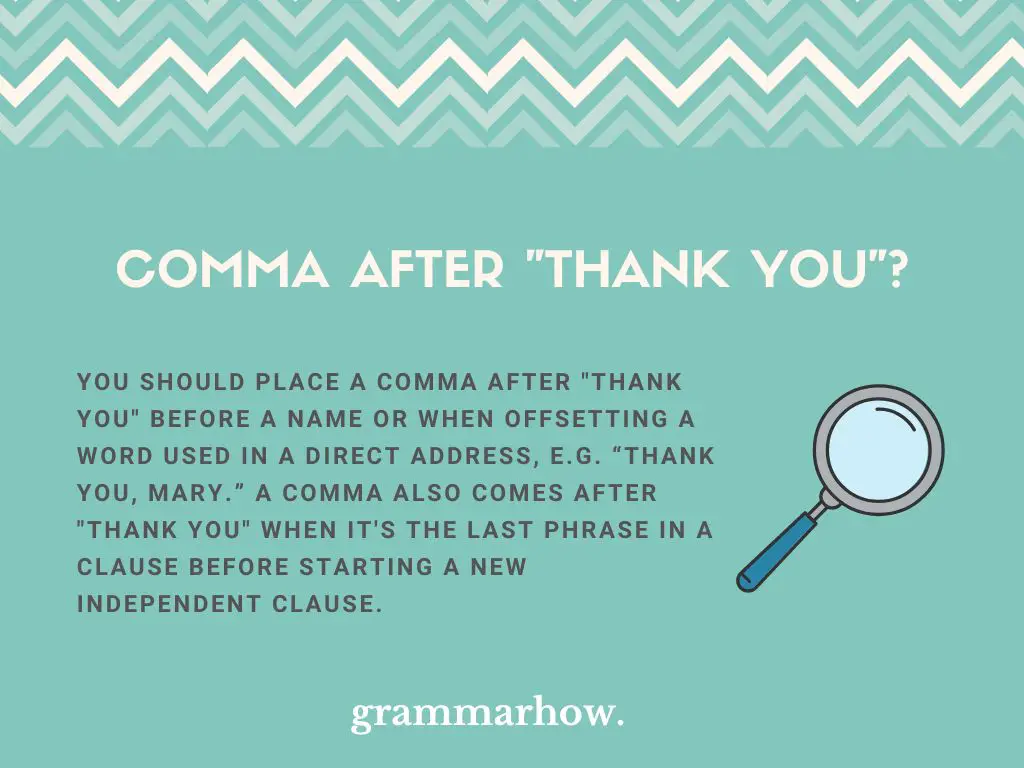“Thank you” is commonly seen with a comma when offsetting names or words used in direct address. This article will help you understand the comma rules associated with using “thank you” in different forms.
Comma After “Thank You”?
You should place a comma after “thank you” before a name or when offsetting a word used in a direct address, e.g. “Thank you, Mary.” A comma also comes after “thank you” when it’s the last phrase in a clause before starting a new independent clause.

Here are some examples showing you the most common way to place a comma after “thank you:”
- Thank you, Jon. I’ll be sure to get on top of that as soon as I can.
- Thank you, Matt. I’m not sure when I’ll be back. I’ll talk to you about it later.
You may refer to The Chicago Manual of Style or the AP Stylebook to learn more about comma rules in writing. Both guides state that commas are used to offset names or words used in a direct address.
The names portion is easy to understand. As long as you include a name after “thank you,” you need a comma:
- Thank you, Mary.
- Thank you so much, Marcus.
You can place the comma after “thank you” or when you’ve completed the entire appreciative phrase (i.e. “thank you so much”).
You should place a comma after “thank you” with the direct address portion when you are directing it towards someone. Even if you don’t mention them explicitly, a comma is still required;
- Thank you, everyone. I’ll do that soon.
- Thank you, all.
- Thank you so much, as you have done me a great service.
There is one final way to place a comma after “thank you.” You may do so when “thank you” comes at the end of the first clause and continues into an independent clause:
- I want to thank you, and I’ll do what I can.
- Thank you, but I don’t think I need your help.
Here, independent clauses come after “thank you.” Each independent clause requires a comma beforehand, meaning the comma falls after “thank you.”
When to Place a Comma Before “Thank You”
You may also find yourself placing a comma before “thank you.” This occurs similarly to the above, but it’s up to you how you want to phrase the sentence.
Check out these two examples:
- Alright, thank you, Steve.
- Alright, Steve, thank you.
Here, Steve is being thanked in the same way. One comes before. One comes after. Both are grammatically correct.
You may include a comma before “thank you” when addressing someone directly by name or addressing them with appreciation.
It’s not as common to place “thank you” after a name or direct address, but it still occurs.
Here are a few more examples to help you out:
- Dave, thank you so much for all your help today! You don’t know what it means to me.
- I’ll do that, Maria, thank you again. I’m not sure what I would have done without you.
- Peter, thank you! I knew you were a genius! You’ve saved my skin.
When to Use “Thank You” Without a Comma
You don’t always need to use a comma with “thank you.” You can avoid using a comma if “thank you” is not directed at someone by name or address.
When this happens, “thank you” is often its own sentence. It is the only phrase used before closing the sentence with a period:
- Thank you. You rock.
- I appreciate that, Darren. Thank you.
- Thank you. I’ll be sure to keep in touch.
As you can see, “thank you” works as a sentence, meaning no commas are required.
You may also avoid commas with “thank you” when referring to someone else, saying “thank you.” If a preposition comes directly after “thank you,” no comma is needed.
- She wanted to say thank you for what you did.
Comma After “Thank You” When Ending an Email?
It’s most common to close emails with commas before someone’s name. Remember, these are the rules stated in both The Chicago Manual of Style and the AP Stylebook. Therefore, there is some merit to these rules.
You should place a comma after “thank you” when ending an email. The line after “thank you” will always be your name, which is used as the offset, meaning that a comma should apply.
The only other option is to place a period after “thank you.” However, this comes across as rude to most readers.
If you avoid punctuation completely with “thank you,” you have made a grammatical error in your email.
Here’s an example showing you how to write “thank you” correctly:
- Dear Joseph,
- This is my email.
- Thank you,
- Ben
What to Remember
“Thank you” always has a comma after it when addressing a person directly. You should be able to remember this based on whether you’ve used someone’s name (i.e. “thank you, name”). You can also place the comma before if you write “name, thank you.”
Also, include a comma after “thank you” when closing an email every time.
“Thank you” can be used without a comma when “thank you” is a sentence, meaning no other words surround it.

Martin holds a Master’s degree in Finance and International Business. He has six years of experience in professional communication with clients, executives, and colleagues. Furthermore, he has teaching experience from Aarhus University. Martin has been featured as an expert in communication and teaching on Forbes and Shopify. Read more about Martin here.
